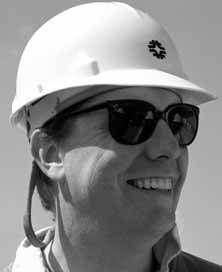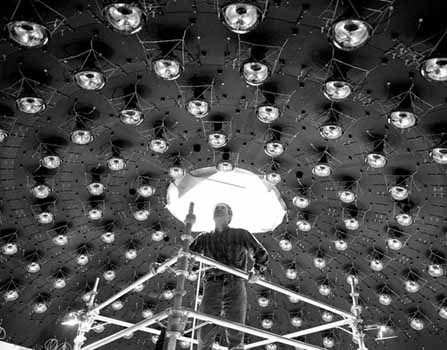 |
|
Engineering Neutrinos by Kurt Riesselmann
Engineering is key to the success of these unique experiments, MiniBooNE and NuMI/MINOS. Digging tunnels, installing infrastructure, assembling detectors, building electronics and aligning particle beams takes years of planning, construction and commissioning, often to unprecedented levels of precision.
Working with physicists and construction companies, Tom Lackowski oversees the engineering of the NuMI project. From the early planning stages of this multi-million-dollar project, he has coordinated the engineering work, making sure that project specifications are maintained throughout construction. He must also accommodate physicists' requests for design changes.
"Civil construction is usually 'way ahead of the physics," said Lackowski. "It would be nice to have all the planning done before construction starts. But it's just not realistic. Technologies are still being developed while the construction of the facilities is going on."
Scientists will use the NuMI beam line at Fermilab to create a neutrino beam and send it 735 kilometers through the earth to the 8-meter-wide MINOS detector, located in a former iron mine in Soudan, Minnesota.
Like many other Fermilab enterprises, the NuMI project is at the forefront of technological feasibility. Physicists require the center of the neutrino beam to hit the core of the MINOS detector within 12 meters. To hit their target, engineers must determine the absolute global positions of the beam line at Fermilab and the detector in Minnesota to within a meter. Then they must align all components of the 300-meter-long beamline at Fermilab within a quarter of a millimeteróless than a micron per meteróto achieve a sufficiently precise aim.
"The original specifications and tolerances came from the physicists," said Bocean. "Based on their physics simulations, they told us the technical parameters they would like to achieve. We reviewed their numbers in conjunction with our surveying capabilities and told them what could be done."
Precisely determining the absolute global position of an underground object, hidden from stars and satellites, is a challenging task. Not to mention that the earth changes its shape a few meters every day because of gravitational forces.
"We used all kinds of methods that are not commonly used," said Bocean. "At Soudan, for example, we couldn't see the bottom of the shaft from the top. Going up and down in the elevator, we used a gyroscope-accelerometer-based inertial navigation system that is normally used in helicopters to transfer coordinates. We lost less than half a meter in precision in all three directions along the 710-meter-deep shaft. Because we determined the surface positions to better than one centimeter, we still met the required tolerances for absolute positioning."
Detector design
Presently, the MiniBooNE collaboration is working on the installation of the devices, usually referred to as PMTs. Engineer Bill Sands, of Princeton University, designed the PMT support structure.
"There are a thousand ways to do it," said Sands. "I used three criteria: structural integrity, ease of fabrication and ease of assembly. Simplicity, of course, is always the keystone."
Beam focusing
Physicists use a focusing device, called a horn, to harvest a larger fraction of secondary particles, forcing them into a forward direction. The horn produces a finely tuned magnetic force field that creates the right strength of force depending on the angle in which secondary particles leave the target.
Both neutrino experiments will use horns. For the MiniBooNE experiment, engineers designed a two-meter-long horn that takes a pulsed current of 170,000 amps to create an appropriate magnetic field 5 times per second, exactly matching the frequency at which packages of protons hit the target.
"The engineering of the focusing horn is the whole show," said Joel Misek, lead engineer of the MiniBooNE beam line. "Building the beam line facility, designing adjustable stands and installing magnets is just our normal bread and butter."
The MiniBooNE horn is expected to last about a year, delivering 100 million pulses. The strong electrical currents forced through the horn require the design of special power supplies and connectors.
"The horn is like a huge coaxial cable operated in pulsed mode," said Larry Bartoszek, who engineers the mechanical design of the horn. "Fatigue is a big concern."
Bartoszek worked at Fermilab as a mechanical engineer from 1983 to 1993 before he started his own consulting business. As a contractor, he continues to work on projects in particle physics around the world.
"The usual commercial work is not as interesting to me," he said. "In those jobs you don't do things that are way out on a limb."
Deep underground, to new heights of precision, or out on a limbóFermilab engineers go wherever neutrino physics takes them.
More on the Web:
|
| last modified 3/16/2001 by C. Hebert email Fermilab |
FRLsDFx9eyfrPXgV
 Wet, dirty and deep underground: a perfect place for a particle experiment. Protected from light and cosmic particles, two underground experiments at Fermilab will catch the particles that usually traverse the earth without leaving a track: neutrinos.
Wet, dirty and deep underground: a perfect place for a particle experiment. Protected from light and cosmic particles, two underground experiments at Fermilab will catch the particles that usually traverse the earth without leaving a track: neutrinos.
 "This kind of project has never been done before," said Virgil Bocean, a geodetic engineer working on the project. He is in charge of building the geodetic network necessary to achieve the required alignment.
"This kind of project has never been done before," said Virgil Bocean, a geodetic engineer working on the project. He is in charge of building the geodetic network necessary to achieve the required alignment.

